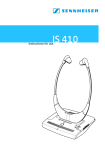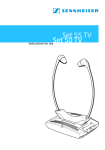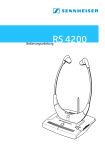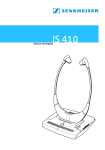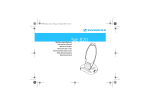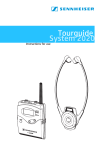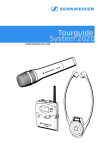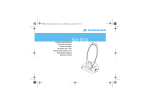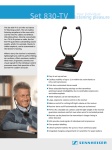Download Sennheiser RS 4200 II - Specifications
Transcript
RS 4200 Instructions for use A B C A B C Contents Safety instructions ........................................................................... 2 The RS 4200 stethoset receiver system .......................................... 3 Delivery includes .............................................................................. 4 RS 4200-2 product variant ................................................................... 4 Operating controls ............................................................................ 5 Receiver (see inside cover) ................................................................... 5 Transmitter (see inside cover) ............................................................. 5 LED indications (see inside cover) ....................................................... 5 Connection possibilities (see inside cover) ....................................... 5 Putting the system into operation .................................................. 6 Setting up the transmitter ................................................................... 6 Connecting the transmitter to the sound source ............................. 6 Connecting the transmitter to the mains .......................................... 8 Inserting and removing the receiver’s rechargeable battery ........ 9 Inserting a spare rechargeable battery into the transmitter’s charging compartment ................................................. 9 Using the system components ...................................................... 10 Switching the transmitter on ............................................................. 10 Switching the stehoset receiver on ................................................... 10 Adjusting the volume .......................................................................... 11 Automatic transmitter search tuning .............................................. 11 Changing the transmission and receiver channel .......................... 11 Adjusting the balance .......................................................................... 12 Enhancing speech intelligibility ......................................................... 12 Storing and charging the receiver ..................................................... 12 Meaning of the LEDs and acoustic signals .................................... 13 LEDs on the transmitter ...................................................................... 13 Acoustic signals of the receiver ......................................................... 13 Care and maintenance .................................................................... 14 Cleaning the system ............................................................................. 14 Cleaning the ear cushions ................................................................... 14 If problems occur... ......................................................................... 15 Accessories ...................................................................................... 16 Connector assignment ................................................................... 16 Specifications .................................................................................. 17 Manufacturer Declarations ............................................................ 18 Thank you for choosing Sennheiser! We have designed this product to give you reliable operation over many years. Over 60 years of accumulated expertise in the design and manufacture of high-quality electro-acoustic equipment have made Sennheiser a world-leading company in this field. Please take a few moments to read these instructions carefully, as we want you to enjoy your new Sennheiser products quickly and to the fullest. 1 Safety instructions y Please read these instructions carefully and completely before using the system. y Make these instructions easily accessible to all users at all times. Always include these instructions when passing the system on to third parties. y Do not wear the headphones in situations which require special attention (e.g. when performing skilled jobs). y Always keep the system dry and do not expose it to extreme temperatures (ideally 10-35°C). y Use the system with care and set it up in a clean, dust-free environment. y Varnish or furniture polish may degrade the feet of the transmitter, which could stain your furniture. You should therefore place the transmitter on a non-slip pad to avoid potential staining of furniture. y This system allows you to set higher volumes than conventional stethoset systems. This can cause hearing damage in persons with healthy hearing and especially in children. y Please observe the safety instructions for Lithium-Ion rechargeable batteries on the enclosed leaflet. Intended use of the system Intended use includes that: y you have read these instructions, especially the chapter “Safety instructions”. y you are using the system within the operating conditions as described in these instructions. Improper use Improper use means use of the system other than as described in these instructions or under operating conditions which differ from those described in these instructions. 2 The RS 4200 stethoset receiver system The RS 4200 is a wireless radio frequency stethoset receiver system with which you can adjust the volume of your TV, radio, personal stereo and other hi-fi equipment to suit your individual needs. The transmitter has a range of up to 100 m (depending on outer conditions) which allows you to move around freely – without the constrictions of cables. The RS 4200 is particularly easy and intuitive to operate. The stethoset receiver automatically switches on when you pull the earbows apart. The volume can be adjusted directly on the receiver. The speech intelligibility can be enhanced at the press of a button on the transmitter. The transmitter has an integrated charging compartment for storing the receiver and simultaneously charging the receiver’s rechargeable battery. In addition, a spare rechargeable battery can be charged in the small charging compartment at the side of the transmitter. 3 Delivery includes Delivery of the RS 4200 stethoset receiver system includes: y 1 RR 4200 stethoset receiver y 1 TR 4200 transmitter with integrated charging compartment y 1 BA 300 Lithium-Ion rechargeable battery y 1 mains unit y 1 connecting cable fitted with two 3.5 mm stereo jack plugs for connection to headphone socket (with one adapter to 1/4“ (6.3 mm) jack socket) y 1 adapter RCA/jack socket for connection to RCA sockets (e.g. TB/Aux-Out) y 2 pairs of replacement ear cushions y Instructions for use RS 4200-2 product variant The RS 4200-2 allows a second person to listen. The scope of delivery of the RS 4200-2 variant is identical to the delivery of the RS 4200 but includes: y 2 RR 4200 stethoset receivers y 2 BA 300 rechargeable batteries y 4 pairs of replacement ear cushions 4 Operating controls A Receiver (see inside cover) B Volume control Compartment for BA 300 rechargeable battery Balance control TUNE button Transmitter (see inside cover) 3.5 mm stereo jack socket labeled AUDIO (marked blue) for connection of sound source Channel selector switch CHANNEL DC socket labeled 9 V (marked yellow) for connection of mains unit “Speech intelligibility” button Antenna Charging compartment for receiver Charging compartment for spare rechargeable battery B LED indications (see inside cover) Charging control LED for spare rechargeable battery Charging control LED for receiver rechargeable battery Operation indication C Connection possibilities (see inside cover) Connecting cable for headphone socket Adapter to 1/4“ (6.3 mm) jack socket Adapter (RCA/jack socket) SCART adapter (optional) Mains unit 5 Putting the system into operation Setting up the transmitter 왘 Choose a suitable place near your sound source (e.g. TV). Note: y Do not place the transmitter close to metal objects such as shelf bars, reinforced concrete walls, etc. as this can decrease the transmitter’s range. y It is not necessary that the transmitter and stethoset receiver are in a direct line of sight, so you can move around freely in the home or outside in the garden. y One transmitter can be used to transmit to several receivers on the same frequency. Connecting the transmitter to the sound source 왘 Plug in one end of the connecting cable to the blue AUDIO socket on the transmitter. 왘 Check the connection possibilities of your sound source (e.g. TV). A B C TV TV AV L Headphone socket 6 D No socket R RCA sockets SCART socket External microphone A Connecting the transmitter via the headphone socket 왘 Plug in the other end of the connecting cable to the headphone socket on your sound source. t oucket so dio e audphon hea 왘 Adjust the volume of the headphone socket on your sound source to a medium level. This improves the quality of wireless sound transmission. If necessary, check the menu setting of your TV. Note: With most TVs, the headphone socket is located at the front or sides. Depending on the socket, you may have to use the adapter . In order to prevent damage to hearing, newer TVs often have a function that mutes the TV sound as soon as headphones are connected. 왘 If another person wants to listen to the TV sound via the loudspeaker, deactivate the muting function via the TV menu setting. B t ou o et di sock au CA R L R Connecting the transmitter via the RCA sockets 왘 Connect the connecting cable to the adapter (RCA/jack socket) . 왘 Connect the red and white RCA connectors of the adapter to the matching red and white RCA sockets on your sound source. Note: With most TVs, the RCA sockets are located at the rear. 7 C Connecting the transmitter via the SCART socket If your sound source has a SCART socket, you can order the suitable SCART adapter (see “Accessories” on page 16) from your Sennheiser dealer. 왘 Connect the connecting cable to the SCART adapter . 왘 Plug in the SCART adapter to the SCART socket on your TV. If your TV has several SCART sockets, select a SCART socket that is also an output (for details, see operating manual of your TV). D Using an external microphone If your sound source doesn’t have a headphone or audio output, SCART or RCA socket, you can use your RS 4200 together with an external microphone (see “Accessories” on page 16). 왘 Connect the microphone to the blue socket AUDIO on the transmitter. 왘 Position the microphone in front of the loudspeaker of your sound source. You can change the sound by varying the position of the microphone in front of the loudspeaker. Connecting the transmitter to the mains 왘 Connect the mains unit to the yellow socket (9 VDC) on the transmitter. 왘 Plug the mains connector into a wall socket. 왘 Align the antenna vertically. Note: Pull the mains connector out of the wall socket when the transmitter will not be used for extended periods of time (e.g. when you are on holiday). In this case, however, the rechargeable battery will not be recharged. 8 Inserting and removing the receiver’s rechargeable battery 왘 Insert the battery into the compartment as shown on the left. Make sure that the battery is inserted correctly. 왘 To remove the battery, use the finger catch projection to pull the battery out of the receiver. Note: y The receiver is delivered with the battery inserted. y Before you use the rechargeable battery for the first time, charge it until the LED lights up green (see “Storing and charging the receiver” on page 12). This can take a maximum of 3 hours. Inserting a spare rechargeable battery into the transmitter’s charging compartment You can charge a spare battery (not included) in the charging compartment at the side of the transmitter. This spare battery is not required for operating the RS 4200 but offers extended listening time while the discharged first battery is being recharged. 왘 Insert the spare battery into the charging compartment as shown on the left. 왘 If the battery is inserted correctly, the LED lights up red: The rechargeable battery is being charged. green: The rechargeable battery is fully charged. 9 Using the system components Switching the transmitter on The transmitter automatically switches on when a sufficient audio signal is present at the headphone socket of your sound source. 왘 Switch your sound source on. This automatically switches on the transmitter and the LED lights up green. 왘 If the transmitter does not switch on, increase the volume of your sound source. Note: If there is no sufficient audio signal for at least 3 minutes, the transmitter automatically switches off. Switching the stehoset receiver on Attention! Volume up? - No! When people use headphones, they tend to choose a higher volume than with loudspeakers. Listening at high volume levels for long periods can lead to permanent hearing defects. Please protect your hearing, Sennheiser headphones also sound exceptionally good at low volumes. OFF ON The stethoset receiver automatically switches on when you pull the earbows apart and put the receiver on. When you take the receiver off, it automatically switches off. 왘 Before putting the receiver on, use the volume control to adjust the volume to a low level. This protects your hearing from damage. 왘 Put the receiver on the correct way round, with the Sennheiser logo at the front. 10 Adjusting the volume 왘 If the transmitter is connected to a headphones socket of your sound source: Adjust the volume of the sound source to a medium level. This improves the quality of wireless sound transmission. 왘 Use the volume control to adjust the volume to a sufficient and comfortable level. Automatic transmitter search tuning 왘 Put the receiver on. The receiver starts searching for a transmitter signal and automatically tunes itself to the last selected channel. If a transmitter signal is found, the transmitter search tuning stops and the receiver produces – depending on the selected channel – 1, 2 or 3 beeps (see “Meaning of the LEDs and acoustic signals” on page 13). The audio transmission then starts. 왘 If the signal found is not the correct one (e.g. from another nearby system): Briefly press the TUNE button to continue the transmitter search tuning. Changing the transmission and receiver channel If several transmitters are operated simultaneously and are very close to one another, reception can be subject to interference (e.g. hissing). 왘 Change the position of the channel selector switch CHANNEL to change the transmission channel. 왘 Press the TUNE button to re-start transmitter search tuning (see previous section). 11 Adjusting the balance The RS 4200 features a balance control for right/left volume adjustment. 왘 Use the balance control to adjust the volume so that you hear equally well with both ears. Enhancing speech intelligibility The button allows you to enhance speech intelligibility. 왘 If the speech is barely intelligible, press the button . The button is backlit in yellow and speech intelligibility is enhanced. Note: If the speech remains barely intelligible, increase the volume of your sound source. Storing and charging the receiver Do not store your receiver on a glass dummy head, chair armrest, or similar for long periods of time as this can reduce the contact pressure of the earbows. Furthermore, with the earbows pulled apart, the receiver remains switched on. 왘 After use, place the receiver into the transmitter’s charging compartment as shown on the left, without exerting too much pressure. 왘 If the receiver is placed correctly into the charging compartment, the LED lights up red: green: The rechargeable battery is being charged. The rechargeable battery is fully charged. 왘 Before you use the rechargeable battery for the first time, charge it until the LED lights up green. This can take a maximum of 3 hours. With a fully charged battery, the operating time is approx. 9 hours. Note: Always store the receiver in the transmitter’s charging compartment to ensure that it is fully charged. The intelligent battery charging technology prevents overcharging. When not using the receiver for extended periods of time, charge the battery regularly every three months. 12 Meaning of the LEDs and acoustic signals LEDs on the transmitter LED Status Meaning lit green Transmitter is switched on off Transmitter is switched off lit red Charging control LED of spare rechargeable battery Spare rechargeable battery or rechargeable battery is being charged lit green Rechargeable battery is fully charged Speech intelligibility” button lit yellow Speech enhancement is activated Operation indication Charging control LED of receiver rechargeable battery Acoustic signals of the receiver Acoustic signal Meaning Commentary 6 short beeps No audio signal (transmitter is not activated or out of range) Automatic switch-off after approx. 3 minutes 2 long beeps Rechargeable battery is flat Automatic switch-off after approx. 10 minutes 1, 2 or 3 beeps after Receiver is tuned to having pressed the channel 1, 2 or 3 TUNE button These beeps can be switched off by pressing the TUNE button for 5 seconds while the receiver is switched on. 13 Care and maintenance Cleaning the system Attention! Liquids can damage the electronics of the units! Liquids entering the housing of the units can cause a short-circuit and damage the electronics. 왘 Keep all liquids far away from the units. 왘 Before cleaning, disconnect the transmitter from the mains. 왘 Only use a slightly damp cloth to clean the units. Do not use any cleansing agents or solvents. Cleaning the ear cushions 왘 Carefully remove the ear cushions from the receiver. 왘 Clean the ear cushions with warm soapy water and rinse thoroughly. 왘 Dry the ear cushions before putting them back on the receiver. Note: For reasons of hygiene, the ear cushions should be replaced from time to time. Please order the ear cushions from your Sennheiser dealer. 14 If problems occur... 왘 Check if the problem you face is listed in the table below: Problem Possible cause You cannot y Are all jack plugs connected correctly? hear anything y Is the transmitter connected to the sound source? Page 6 ff 6 ff y Is the transmitter connected to the mains? 8 y Is the volume of the sound source sufficient? 6 y Is the green operation indication lit? 8 y Is the volume of the receiver sufficient? 11 y Is the rechargeable battery fully charged and inserted properly into the receiver? 9 The sound is subject to interference y Is the receiver still within the transmitter’s range? 6 y Is interference being received from an external source in close proximity? 11 The speech intelligibility is reduced y Is the “Speech intelligibility” button backlit in yellow? 12 y Is the volume of the headphone socket on the sound source sufficient? 10 You hear the sound only with one ear y Is the balance adjusted correctly? 12 If problems occur that are not listed in the above table or if the problems cannot besolved with the proposed solutions, please contact your local Sennheiser agent for assistance. 15 Accessories Attention! Components from other manufacturers (e.g. for power supply or rechargeable battery) may cause damage to the unit and will invalidate the warranty. 왘 Only use original Sennheiser accessories and spare parts. The following accessories are available from your authorized Sennheiser dealer: BA 300 spare rechargeable battery Cat. No. 500898 RR 4200 receiver Cat. No. 500685 Ear cushions (normal), 5 pairs Cat. No. 517625 Ear cushions (lamellar form), 5 pairs Cat. No. 517626 SCART adapter Cat. No. 077798 MKE 800 TV-N Cat. No. 500974 external microphone (mono) Connector assignment The blue socket AUDIO is designed for use with two different connector types (Line/Mic). The connector type used is identified automatically. 3.5 mm 3-pole jack/standard stereo L R GND 3.5 mm 4-pole jack/microphone with additional power supply L R 8V GND 1kΩ 16 Specifications System Modulation FM stereo Carrier frequencies 863.3 / 864.0 / 864.7 MHz Range up to 100 m in the open AF frequency response 50 Hz–16 kHz THD <1% Transmitter Audio /microphone connection 3.5 mm stereo jack socket Charging time of rechargeable battery approx. 3 hrs Power supply 9 VDC/300 mA via NT 4200 mains unit Weight approx. 150 g Dimensions approx. 115 x 145 x 95 mm Receiver Max. SPL 125 dB (SPL) Power supply via BA 300 rechargeable battery (3.7 V / 150 mAh) Operating time approx. 9 hrs Weight approx. 50 g Dimensions approx. 200 x 135 x 20 mm 17 Manufacturer Declarations Warranty regulations The guarantee period for this Sennheiser product is 24 months from the date of purchase. Excluded are accessory items, rechargeable or disposable batteries that are delivered with the product; due to their characteristics these products have a shorter service life that is principally dependent on the individual frequency of use. The guarantee period starts from the date of original purchase. For this reason, we recommend that the sales receipt be retained as proof of purchase. Without this proof (which is checked by the responsible Sennheiser service partner) you will not be reimbursed for any repairs that are carried out. Depending on our choice, guarantee service comprises, free of charge, the removal of material and manufacturing defects through repair or replacement of either individual parts or the entire device. Inappropriate usage (e.g. operating faults, mechanical damages, incorrect operating voltage), wear and tear, force majeure and defects which were known at the time of purchase are excluded from guarantee claims. The guarantee is void if the product is manipulated by non-authorised persons or repair stations. In the case of a claim under the terms of this guarantee, send the device, including accessories and sales receipt, to the responsible service partner. To minimise the risk of transport damage, we recommend that the original packaging is used. Your legal rights against the seller, resulting from the contract of sale, are not affected by this guarantee. The guarantee can be claimed in all countries outside the U.S. provided that no national law limits our terms of guarantee. CE Declaration of Conformity This equipment is in compliance with the essential requirements and other relevant provisions of Directive 89/336/EC. The declaration is available on the internet site at www.sennheiser.com. Before putting the device into operation, please observe the respective countryspecific regulations! Frequency range 863-865 MHz, approved in: A, B, CH, CY, CZ, D, DK, E, EST, F, FIN, FL, GB, GR, H, I, IRL, IS, L, LT, LV, M, N, NL, P, PL, S, SK, SLO Batteries or rechargeable batteries The supplied batteries or rechargeable batteries can be recycled. Please dispose of them as special waste or return them to your specialist dealer. In order to protect the environment, only dispose of exhausted batteries. WEEE Declaration Your Sennheiser product was developed and manufactured with high-quality materials and components which can be recycled and/or reused. This symbol indicates that electrical and electronic equipment must be disposed of separately from normal waste at the end of its operational lifetime. Please dispose of this product by bringing it to your local collection point or recycling centre for such equipment. This will help to protect the environment in which we all live. 18 Sennheiser electronic GmbH & Co. KG 30900 Wedemark, Germany Phone +49 (5130) 600 0 Fax +49 (5130) 600 300 www.sennheiser.com Printed in China Publ. 10/06 517634 / A02
























